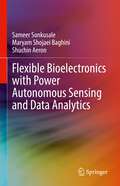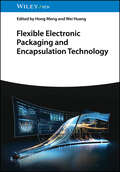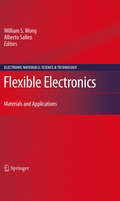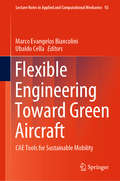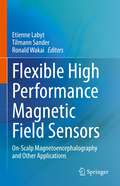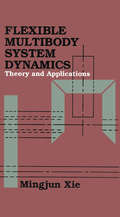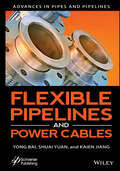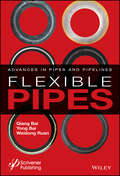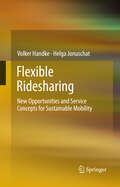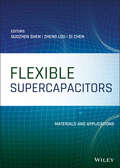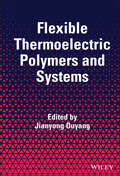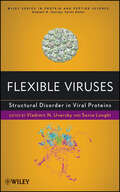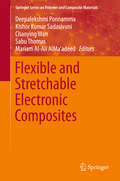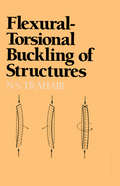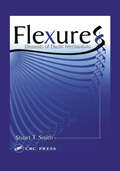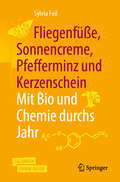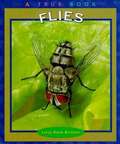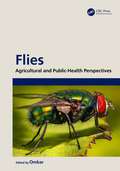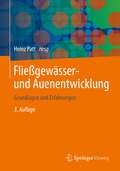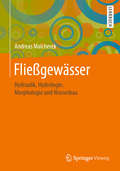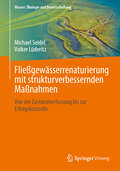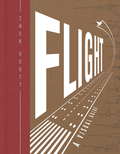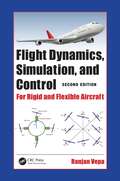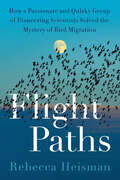- Table View
- List View
Flexible Bioelectronics with Power Autonomous Sensing and Data Analytics
by Sameer Sonkusale Maryam Shojaei Baghini Shuchin AeronThis book provides readers with an introduction to the materials and devices necessary for flexible sensors and electronics, followed by common techniques for fabrication of such devices and system-level integration. Key insights into fabrication and processing will guide readers through the tradeoff choices in designing such platforms. A comprehensive review of two specific, flexible bioelectronic platforms, related to smart bandages for wound monitoring and thread-based diagnostics for wearable health, will demonstrate practical application at the system level. The book also provides a unique electrical engineering perspective by reviewing circuit architectures for low noise signal conditioning of weak signals from sensors,, and for low power analog to digital converters for signal acquisition. To achieve energy autonomy, authors provide several example of CMOS energy harvesting front end circuits and voltage boosters. Beyond circuit architectures, the book also provides a review of the modern theory of sampling and recovery of sparse signals, also known as compressed sensing. They then highlight how these principles can be leveraged for design and implementation of efficient signal acquisition hardware and reliable processing of acquired data for flexible electronic platforms.
Flexible Electronic Packaging and Encapsulation Technology
by Hong MengFlexible Electronic Packaging and Encapsulation Technology A systematic introduction to the future of electronic packaging Electronic packaging materials are among the most important components of the broader electronics industry, capable of facilitating heat dissipation, redistributing stress on electronic components, and providing environmental protections for electronic systems. Recent advances in integrated circuits, especially the development of flexible electronic technology, have placed increasingly stringent demands on the capabilities of electronic packaging. These technologies have the potential to reshape our world, and they demand a generation of engineers capable of harnessing that potential. Flexible Electronic Packaging and Encapsulation Technology meets this demand with an introduction to the cutting-edge technologies available to package electronic components, as well as the testing methods and applications that bring these technologies to bear on the industry. These packaging technologies promise to bring lightness, flexibility, and environmental friendliness to the next generation of electronic systems. Flexible Electronic Packaging and Encapsulation Technology readers will also find: Survey of commercial electronic packaging materials and patents for reference purposesGuidelines for designing high-performance packaging materials with novel structuresAn authorial team of leading researchers in the field Flexible Electronic Packaging and Encapsulation Technology is ideal for materials scientists, electronics engineers, solid state physicists, professionals in the semiconductor industry, and any other researchers or professionals working with electronic systems.
Flexible Electronics
by Alberto Salleo William S. WongThis excellent volume covers a range of materials used for flexible electronics, including semiconductors, dielectrics, and metals. The functional integration of these different materials is treated as well. Fundamental issues for both organic and inorganic materials systems are included. A corresponding overview of technological applications, based on each materials system, is presented to give both the non-specialist and the researcher in the field relevant information on the status of the flexible electronics area.
Flexible Engineering Toward Green Aircraft: CAE Tools for Sustainable Mobility (Lecture Notes in Applied and Computational Mechanics #92)
by Marco Evangelos Biancolini Ubaldo CellaThis book discusses the recent advances in aircraft design methodologies. It provides an overview of topics such as shape optimization, robust design and aeroelasticity, focusing on fluid-structure numerical methodologies to address static and dynamic aeroelastic problems. It demonstrates that the capability to evaluate the interaction between aerodynamics, inertia and elastic forces is important to avoid drag penalties, control system efficiency loss and generation of potentially dangerous phenomena, such as divergence, control reversal and flutter. The book particularly highlights the advances in “high fidelity” CFD-CSM coupling, describing the latest experimental research to validate the numerical fluid-structure interaction analysis methodologies resulting from the EU-funded RBF4AERO and RIBES projects.
Flexible High Performance Magnetic Field Sensors: On-Scalp Magnetoencephalography and Other Applications
by Etienne Labyt Tilmann Sander Ronald WakaiThis contributed volume reviews the latest advances in all the new technologies currently developed for MagnetoEncephaloGraphy (MEG) recordings, as well as sensor technologies and integrated sensor arrays for on-scalp MEG. The book gives an account of the first MEG imaging studies and explores the new field of feasible, experimental paradigms of on-scalp MEG. This is an ideal book for engineers, researchers, and students in the neurosciences interested in MEG imaging.
Flexible Multibody System Dynamics: Theory And Applications
by Mingjun XieThis volume examines the theoretical and practical needs on the subject of multibody system dynamics with emphasis on flexible systems and engineering applications. lt focuses on developing an all purpose algorithm for the dynamic simulation of flexible tree-like systems making use of matrix representation at all levels. The book covers new theories with engineering applications involved in broad fields which include; civil engineering, aerospace and robotics, as well as general and mechanical engineering. The applications include high temperature conditions, time variant contact conditions, biosystem analysis, vibration minimization and control.
Flexible Pipelines and Power Cables (Advances in Pipes and Pipelines)
by Yong Bai Shuai Yuan Kaien JiangThe technology, processes, materials, and theories surrounding pipeline construction, application, and troubleshooting are constantly changing, and this groundbreaking series, "Advances in Pipes and Pipelines," has been created to meet the needs of engineers and scientists to keep them up to date and informed of all of these advances. This latest volume in the series focuses on flexible pipelines and power cables, offering the engineer the most thorough coverage of the state of the art available. The authors of this work have written numerous books and papers on these subjects and are some of the most influential authors on flexible pipes in the world, contributing much of the literature on this subject to the industry. This new volume is a presentation of some of the most cutting-edge technological advances in technical publishing. This is the most comprehensive and in-depth series on pipelines, covering not just the various materials and their aspects that make them different, but every process that goes into their installation, operation, and design. This is the future of pipelines, and it is an important breakthrough. A must-have for the veteran engineer and student alike, this volume is an important new advancement in the energy industry, a strong link in the chain of the world's energy production.
Flexible Pipes: Advances in Pipes and Pipelines
by Qiang Bai Weidong Ruan Yong BaiRecent changes in the codes for building pipelines has led to a boom in the production of new materials that can be used in flexible pipes. With the use of polymers, steel, and other new materials and variations on existing materials, the construction and, therefore, the installation and operation of flexible pipes is changing and being improved upon all over the world. The authors of this work have written numerous books and papers on these subjects and are some of the most influential authors on flexible pipes in the world, contributing much of the literature on this subject to the industry. This new volume is a presentation of some of the most cutting-edge technological advances in technical publishing. This is the most comprehensive and in-depth book on this subject, covering not just the various materials and their aspects that make them different, but every process that goes into their installation, operation, and design. The thirty-six chapters, divided up into four different parts, have had not just the authors of this text but literally dozens of other engineers who are some of the world’s leading scientists in this area contribute to the work. This is the future of pipelines, and it is an important breakthrough. A must-have for the veteran engineer and student alike, this volume is an important new advancement in the energy industry, a strong link in the chain of the world’s energy production.
Flexible Ridesharing
by Volker Handke Helga JonuschatIndividual mobility is one of the most important needs of modern society and an important link between private, public and economic life. In contrast, transport also entails severe environmental and social burdens, foiling current efforts for sustainable development. As the main source of CO2 emissions, transport is a prominent driver for climate change, and individual car traffic is responsible for nearly a third of the total energy consumption. However, we have to consider that many commuters feel indeed very dependent on their car. Here, ridesharing promises to contribute to environmental protection, while still offering individual mobility. Although ridesharing options have been discussed since many years, internet and smartphones provide completeley new opportunities to find ridesharing partners today. Thus, this book deals with current efforts on implementing flexible internet- and phone-based ridesharing services. With a main focus on the users' perspective, their demands and acceptance limits, we aim to explore success factors for non-profit, but also commercial ridesharing concepts.
Flexible Supercapacitors: Materials and Applications
by Guozhen Shen Zheng Lou Di ChenFLEXIBLE SUPERCAPACITORS Comprehensive coverage of the latest advancements in flexible supercapacitors In Flexible Supercapacitors: Materials and Applications, a team of distinguished researchers deliver a comprehensive and insightful exploration of the foundational principles and real-world applications of flexible supercapacitors. This edited volume includes contributions from leading scientists working in the field of flexible supercapacitors. The book systematically summarizes the most recent research in the area, and covers fundamental concepts of electrode materials and devices, including on-chip microsupercapacitors and fiber supercapacitors. The latest progress and advancements in stretchable supercapacitors and healable supercapacitors are also discussed, as are problems and challenges commonly encountered in the development of flexible supercapacitors. The book concludes with suggestions and fresh perspectives on future research in this rapidly developing field. Flexible Supercapacitors: Materials and Applications also offers: A thorough introduction to the fundamentals of supercapacitors, including their materials and devices Comprehensive explorations of flexible fiber supercapacitors and two-dimensional materials for flexible supercapacitors In-depth examinations of flexible supercapacitors with metal oxides-based electrodes and flexible on-chip microsupercapacitors Practical discussions of stretchable and healable supercapacitors, as well as patterned nanostructured electrodes Perfect for researchers in the fields of materials science, physics, and electrical engineering, Flexible Supercapacitors: Materials and Applications is also an ideal reference for developers interested in supercapacitor design, materials, and devices.
Flexible Thermoelectric Polymers and Systems
by Jianyong OuyangFlexible Thermoelectric Polymers and Systems Comprehensive review of the rapidly evolving field of flexible thermoelectric polymers Flexible Thermoelectric Polymers and Systems delivers an expansive exploration of the most recent developments in flexible thermoelectric polymers and composites, as well as their applications in thermoelectric generators and Peltier coolers. The book focuses on novel designs and applications of technologies such as low-dimensional thermoelectric materials and how the latest advances have begun to overcome problems including poor mechanical flexibility and high fabrication costs. The book begins with a review of the fundamentals of thermoelectric materials, including discussions of the properties of thermoelectric materials, the Seebeck, Peltier, and Thomson effects, electrical conductivity, thermal conductivity, and thermoelectric generators, cooling, and sensors. It goes on to discuss more advanced developments in the field, such as flexible thermoelectric plastics and the thermoelectric properties of conducting polymers with ionic conductors. The book also includes: Thorough introductions to thermoelectric materials and systems, as well as the chemistry and physics of intrinsically conductive polymers Comprehensive explorations of thermoelectric PEDOTs, p-type thermoelectric polymers, and N-type thermoelectric polymers Practical discussions of thermoelectric composites of carbon nanotubes, graphene, and nanomaterials In-depth examinations of polymer composites of inorganic thermoelectric semiconductors Perfect for academic and industrial researchers and engineers in physics, materials science, chemistry, and engineering, Flexible Thermoelectric Polymers and Systems is also an indispensable resource for graduate students and early-career professionals working in those fields.
Flexible Viruses
by Vladimir Uversky Sonia LonghiThis book provides up-to-date information on experimental and computational characterization of the structural and functional properties of viral proteins, which are widely involved in regulatory and signaling processes. With chapters by leading research groups, it features current information on the structural and functional roles of intrinsic disorders in viral proteomes. It systematically addresses the measles, HIV, influenza, potato virus, forest virus, bovine virus, hepatitis, and rotavirus as well as viral genomics. After analyzing the unique features of each class of viral proteins, future directions for research and disease management are presented.
Flexible and Stretchable Electronic Composites
by Sabu Thomas Deepalekshmi Ponnamma Mariam Al-Ali AlMa'adeed Kishor Kumar Sadasivuni Chaoying WanThis book is the first comprehensive collection of electronic aspects of different kinds of elastomer composites, including combinations of synthetic, natural and thermoplastic elastomers with different conducting fillers like metal nanoparticles, carbon nanotubes, or graphenes, and many more. It covers elastomer composites, which are useful in electronic applications, including chemical and physical as well as material science aspects. The presented elastomer composites have great potential for solving emerging new material application requirements, for example as flexible and wearable electronics. The book is structured and organized by the rubber/elastomer type: each chapter describes a different elastomer matrix and its composites. While introducing to important fundamentals, it is application-oriented, discussing the current issues and challenges in the field of elastomer composites. This book will thus appeal to researchers and scientists, to engineers and technologists, but also to graduate students, working on elastomer composites, or on electronics engineering with the composites, providing the readers with a sound introduction to the field and solutions to both fundamental and applied problems.
Flexural-Torsional Buckling of Structures (New Directions In Civil Engineering Ser. #6)
by N. S. TrahairFlexural-Torsional Buckling of Structures provides an up-to-date, comprehensive treatment of flexural-torsional buckling and demonstrates how to design against this mode of failure. The author first explains the fundamentals of this type of buckling behavior and then summarizes results that will be of use to designers and researchers in either equation or graphical form. This approach makes the book an ideal text/reference for students in structural engineering as well as for practicing civil engineers, structural engineers, and constructional steel researchers and designers. The book begins by introducing the modern development of the theory of flexural-torsional buckling through discussions on the general concepts of equilibrium, total potential, virtual work, and buckling. It then continues with in-depth coverage of hand methods for solving buckling problems, the analysis of flexural-torsional buckling using the finite element method, and the buckling of different types of structural elements and frames composed of various elastic materials. Other topics addressed include the design and inelastic buckling of steel members. The book's final chapter considers a collection of special topics.
Flexures: Elements of Elastic Mechanisms
by Stuart T. SmithThis book presents some basic flexure geometries and the analytic models, which can be assessed for specific design applications. The author then goes beyond this fundamental explanation to explore more sophisticated issues. Specifically, the text discusses integration of these flexure geometries and analytic models to produce useful mechanisms for
Fliegenfüße, Sonnencreme, Pfefferminz und Kerzenschein | Mit Bio und Chemie durchs Jahr
by Sylvia FeilWoher wissen Bäume, dass es Frühling ist? Wie wirkt Tageslicht auf der Haut? Was macht Frost mit Trauben? Was hat die Photosynthese mit Quantenphysik zu tun? Sind Ingwer und Kurkuma wirklich so gesund? Monat für Monat streifen Leserinnen und Leser mit diesem Buch durch die Jahreszeiten. Die Kapitel greifen interessante Phänomene aus der Natur auf und erklären ihre chemischen und biologischen Hintergründe.Am Jahresanfang lernen wir etwas über die Wirkung von Streusalz und wie Sonnenlicht gegen den Winterblues hilft, im Frühling begegnen uns im Moor sprießende Moose und klebrige Pflanzen, im Sommer erklärt die Autorin, wieso wir schwitzen und was man dagegen machen kann. Im Herbst werden Gewürzvorräte angelegt und die Weinernte beginnt – im Winter erleuchten uns Kerzenschein und Kometenschweife.
Flies: A True Book
by Larry Dane BrimnerDescribes the physical characteristics, behavior, and life cycle of flies and discusses some of the different kinds.
Flies: Agricultural and Public-Health Perspectives
by OmkarThe term "flies" applies to the insects belonging to the order Diptera, more commonly known as flies, gnats, midges, and leaf miners. They typically possess a pair of antennae, a set of sponging‑type mouthparts, two developed forewings for flight, and two hindwings which are used for aerial balance.Flies occupy unique and diverse roles within our ecosystem: some are pests which affect our agricultural and horticultural crops; other varieties act as vectors that spread diseases within the human and animal population. However, not all flies are harmful to humans: some species of fly play a role in facilitating crop pollination, whilst others are involved in environmental engineering, waste decomposition, and/or nutrient recycling, forming an important component of integrated pest management as effective biocontrol agents. Others even play a role in crime solving within the field of forensic entomology.Flies: Agricultural and Public-Health Perspectives has been planned with a holistic approach to highlight both the positive and negative aspects of flies. This book starts with a chapter on the introduction to flies, followed by insects of agricultural and horticultural importance, flies as vectors, and beneficial flies. Designed with ease of reader use in mind, each chapter includes "pointwise learning objectives" at the beginning, as well as "conclusions" and "points to remember" at the end.This book will be useful not only to students of entomology, public health, agriculture, and applied life sciences but also to those involved in policy planning and vector management. In addition, this book will benefit students preparing for competitive examinations as well as the public.
Fließgewässer- und Auenentwicklung: Grundlagen und Erfahrungen
by Werner Konold Peter Meyer Stephan Von Keitz Walter Binder Mario Sommerhäuser Michael Schirmer Klaus Arzet Birgit Beckers Hubertus Brückner Holger Brux Dieter Coldewey Alexandra Dehnhardt Ulrich Detering Sebastian Döbbelt-Grüne Joachim Drüke Thomas-Ols Eggers Klaus-Dieter Fröhlich Christian Göldi Josef Groß Anja Kaussow Ellen Kiel Uwe Koenzen Annette Kurth Roland Loerbroks Helmut Mader Dietmar Mehl Thomas Paulus Tanja Pottgieser Bernd Schackers Jörg Scholle Georg Schrenk Peter Sellheim Mechtild Semrau Simon Spinner Eberhard Städtler Bernd Walser Klaus Werk Michael WeyandDieses Fachbuch erläutert die Grundlagen für die Entwicklung von Fließgewässern und Gewässerauen und hilft dabei an den Erfahrungen der Autoren teilzuhaben. Aktuelle Vorgehensweisen zum Umgang mit einer dynamischen Gewässer- und Auenentwicklung werden nachvollziehbar dargestellt und durch zahlreiche Beispiele aus unterschiedlichen Gewässerlandschaften ergänzt. Zur Erreichung der ambitionierten Ziele der Europäischen Wasserrahmenrichtlinie (WRRL) sind die gewässerökologischen, naturschutzfachlichen und hydromorphologischen Bedingungen (u.a. Hoch- und Niedrigwasser) im Gewässerkörper und in den angrenzenden Bereichen (u.a. die Gewässerauen), bei der Planung und Gestaltung zu berücksichtigen. Eine ganzheitliche Betrachtungsweise ist dabei Grundvoraussetzung.
Fließgewässer: Hydraulik, Hydrologie, Morphologie und Wasserbau
by Andreas MalcherekDas vorliegende Buch vermittelt Studierenden die hydrologischen, hydraulischen und wasserbaulichen Grundlagen für Gerinne und Fließgewässer. Mit den Programmierbeispielen können die Inhalte geübt und vertieft werden.
Fließgewässerrenaturierung mit strukturverbessernden Maßnahmen: Von der Zustandserfassung bis zur Erfolgskontrolle (Wasser: Ökologie und Bewirtschaftung)
by Michael Seidel Volker LüderitzWie können strukturverbessernde Maßnahmen an Fließgewässern wirksamer umgesetzt werden? Dieses Buch zeigt die Bedeutung der Erfolgskontrolle als Grundlage der Optimierung von Revitalisierungsmaßnahmen an Fließgewässern. Sowohl etablierte als auch neu entwickelte Methoden und Verfahren sind vorgestellt. Es ist besprochen, wie der Fließgewässerzustand erfasst wird, warum Ziele realistischer und konkreter als bisher üblich zu formulieren sind und warum die Wiederherstellung von Funktionen und Prozessen so wichtig ist. Mit welchen Maßnahmen vor diesem Hintergrund vorrangig begonnen werden sollte, ist ebenso dargestellt wie die Frage, auf welche Weise der Erfolg objektiv und effizient bewertet werden kann. Insgesamt entsteht ein besseres Grundverständnis für das Thema sowie für die Wasserrahmenrichtlinie. Ziel des Buches ist, dass Maßnahmen in der Praxis geeigneter priorisiert, wirksamer geplant und umgesetzt werden können. Können Erfolge besser aufgezeigt werden, fördert dies die Akzeptanz in der Öffentlichkeit.
Flight
by Zack ScottFlight is the story of humankind's most ambitious undertaking. From thousand-year-old flying machines and the trailblazing 'birdmen' who risked their lives to test them, to the Wright brothers' legendary first flight and the iconic spacecraft of the modern era, Flight weaves together the extraordinary history of aviation with an in-depth look at the mechanics of how planes work. Sumptuously illustrated and written by a former RAF technician, this is the definitive guide to how we conquered the skies.
Flight
by Zack ScottFlight is the story of humankind's most ambitious undertaking. From thousand-year-old flying machines and the trailblazing 'birdmen' who risked their lives to test them, to the Wright brothers' legendary first flight and the iconic spacecraft of the modern era, Flight weaves together the extraordinary history of aviation with an in-depth look at the mechanics of how planes work. Sumptuously illustrated and written by a former RAF technician, this is the definitive guide to how we conquered the skies.
Flight Dynamics, Simulation, and Control: For Rigid and Flexible Aircraft
by Ranjan VepaFlight Dynamics, Simulation, and Control of Aircraft: For Rigid and Flexible Aircraft explains the basics of non-linear aircraft dynamics and the principles of control-configured aircraft design, as applied to rigid and flexible aircraft, drones, and unmanned aerial vehicles (UAVs). Addressing the details of dynamic modeling, simulation, and control in a selection of aircraft, the book explores key concepts associated with control-configured elastic aircraft. It also covers the conventional dynamics of rigid aircraft and examines the use of linear and non-linear model-based techniques and their applications to flight control. This second edition features a new chapter on the dynamics and control principles of drones and UAVs, aiding in the design of newer aircraft with a combination of propulsive and aerodynamic control surfaces. In addition, the book includes new sections, approximately 20 problems per chapter, examples, simulator exercises, and case studies to enhance and reinforce student understanding. The book is intended for senior undergraduate and graduate mechanical and aerospace engineering students taking Flight Dynamics and Flight Control courses. Instructors will be able to utilize an updated Solutions Manual and figure slides for their course.
Flight Paths: How a Passionate and Quirky Group of Pioneering Scientists Solved the Mystery of Bird Migration
by Rebecca HeismanThe captivating, little-known true story of a group of scientists and the methods and technology they developed to uncover the secrets of avian migration.For the past century, scientists and naturalists have been steadily unravelling the secrets of bird migration. How and why birds navigate the skies, traveling from continent to continent—flying thousands of miles across the earth each fall and spring—has continually fascinated the human imagination, but only recently have we been able to fully understand these amazing journeys. Although we know much more than ever before, even the most enthusiastic birdwatcher may not know how we got here, the ways that the full breadth of scientific disciplines have come together to reveal these annual avian travels.Flight Paths is the never-before-told story of how a group of migration-obsessed scientists in the twentieth and twenty-first centuries engaged nearly every branch of science to understand bird migration—from where and when they take off to their flight paths and behaviors, their destinations and the challenges they encounter getting there. Uniting curious minds from across generations, continents, and disciplines, bird enthusiast and science writer Rebecca Heisman traces the development of each technique used for tracking migratory birds, from the first attempts to mark individual birds to the cutting-edge technology that lets ornithologists trace where a bird has been, based on unique DNA markers. Along the way, she touches on the biggest technological breakthroughs of modern science and reveals the almost-forgotten stories of the scientists who harnessed these inventions in service of furthering our understanding of nature (and their personal obsession with birds).The compelling and fascinating story of how scientists solved the great mystery of bird migration, Flight Paths is an unprecedented look into exciting, behind-the-scenes moments of groundbreaking discovery. Heisman demonstrates that the real power of science happens when people work together, focusing their minds and knowledge on a common goal. While the world looks to tackle massive challenges involving conservation and climate, the story of migration research offers a beacon of hope that we can find solutions to difficult and complex problems.
